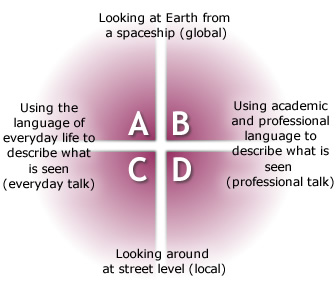Skills for professional supervision


Overview
In this module we examine the skills that you need to be a successful professional supervisor/mentor. We begin by asking you to assess your personal strengths and weaknesses in the supervisory role. We then identify ways in which you can develop your skills in key areas.
Module outcomes

By the end of this module you will be able to:
- Identify your own strengths and weaknesses as a supervisor
- Develop skills in progressive focusing, building trust, listening, communicating, observing and guiding
- Encourage learning and reflective practice
- Understand how to provide constructive feedback.
Identifying your strengths and weaknesses
You do not have the required browser technologies to view this content.
Let's begin by exploring the personal strengths and weaknesses that you bring to the role of professional supervisor.
Task
Open My Learning Journal and turn to the section 'SWOT analysis'. Use the chart to fill in as many features of strengths, weaknesses, opportunities and threats to you as a professional supervisor as you can.
Use the checklist of ideas in the Journal to help you. Include as many things as you can, even if you think that some of them are quite similar. If you aren't a Professional Supervisor at the moment, then imagine you are in the role and do the same activity.
If you have already saved My Learning Journal, as described in module 1, please open it now. If you have not yet set up your own journal, click on the link below and save the document to your computer.
Keep your SWOT analysis handy so that you can revisit it at a later date.
Building on your experiences

Task
Think back to the last time that you were with a colleague and you found yourself offering them support. Play the scene over in your mind and write an account of it. As a starting point, think about what went on, who said what, and how you saw yourself as offering support. Write your account in My Learning Journal, in the section 'Offering support'.
After you have done this, compare your SWOT lists with the account you just made. Try to find an instance of each of the features you listed under the headings Strengths and Weaknesses. Mark sentences in your account with an S or a W (or use the Notes column) if you think they indicate particular strengths or weaknesses. Then try opening this up and go through the same process with Opportunities and Threats.
- View our thoughts
-
Can you see opportunities in the scene you have examined that would help you build on your strengths? If you can't think of any at the moment, you can come back to this list and develop it further later on. Use a SWOT analysis to position yourself and your supervision. It will help you to improve your skills as a supervisor because you will become better informed about yourself and your capabilities as you go through the course.
A different angle on the SWOT analysis
You may find it useful to look at things from the perspective of the other person.
Think about...
Think about the scene you have just written and imagine yourself in the place of your colleague. How do you think they might have done a SWOT analysis of what went on?
Do you have any sense of what your colleague thinks their strengths are? Are there areas where your colleague knows they are less confident - or that they had opportunities that they did not take up? Could you have done anything else, perhaps by capitalising on your own strengths that would have helped your colleague to recognise and take up an opportunity at work?
- View our thoughts
-
Using a SWOT analysis can help you see how your position as a supervisor is working out. It helps you to:
- Think about you - what you are doing well and what you are doing less well
- Analyse your reactions to your situation and your potential to act on that situation in a realistic way, bearing in mind constraints that might operate on you
Keep this initial analysis. As you go through the materials you will do more detailed work on your situation and you will begin to see opportunities open up.
What is progressive focusing?

Common sense is not innate; it is part of what we all learn by reacting to and inter-acting with other people. Similarly, when you try to analyse what goes on at work, you have to find the appropriate focus. This depends on your purposes at a particular point in time. In order to get an overall sense of a situation, you could try using the strategy of 'progressive focusing'. The idea is shown in the diagram.
As you supervise students/trainees at work you will want to change the level of discussion about both practice and theory at various points.
You won't always want to operate at the same level, either in thinking about practice or in theoretical terms. Sometimes you want to draw back and look at things from a greater distance, at other times you may want to look at things in detail.
Similarly, sometimes you will want to use professional language to discuss your observations or practice, while at other times it will be more appropriate to use everyday language.
Moving between these levels involves changing your focus. Imagine using a camera with a telephoto lens in a garden. When you start, a rose may appear to be just a blob of colour in the distance, but when you bring it into close focus, it becomes a clearly identifiable flower perhaps with dew drops on it.
It is important to develop and use this skill of changing focus in your assessment practice.
Click on the link below for more information about using this model in your supervision sessions.
Your perspective of progressive focusing

Task
Keeping the progressive focusing diagram in mind, where does supervising lie on it for you? Make a note of your thoughts in My Learning Journal, in the section 'Progressive focusing'.
- View our thoughts
-
It may be that in some circumstances the most appropriate way for you to support your student/trainee is to offer them a framework. This would enable them to look at what they do 'at street level' rather than from the spaceship.
Possibly, you might want to help them explore how they talk about things so it is more professional in some contexts, less in others. You might want them to lift their eyes from street level to see more of the big picture that the spaceship view provides.
There is no right or wrong way to occupy the diagram, but being aware of where your conversations and interactions are taking you is a useful plotting device for future conversations. If you are talking to a student/trainee about their career development then your conversation may inhabit the whole chart. In other words, your conversation may cover the wider professional arena right down to detail about the work environment and how they feel, both personally and professionally.
Listening and communicating

Effective communication is another vital ingredient in establishing and developing a successful supervisory relationship. Of all the qualities apparent in a good supervisor, the ability to communicate is probably the most important.
Communication includes active listening and being aware of the non-verbal messages being sent by the person speaking. As a supervisor, you need to be able to listen not just to the content of what is being said, but also to the way it is being said and the feelings behind that.
Task
There are a number of pitfalls to not listening properly. Make an assessment of your own listening skills by filling in the matrix in My Learning Journal, in the section 'The pitfalls of not listening'.
- View our thoughts
-
We often assume we have assimilated the maximum possible from any one piece of information. However, recording a conversation and playing it back will reveal the amount of information we have missed.
It is also noticeable, when playing back recorded conversations, that we often fail to appreciate the complex meanings that are communicated during face-to-face interactions. We suddenly hear new things that we somehow missed the first time. An explicit focus on listening - as a distinctive skill - aims to address these issues.
Listening and communicating (cont'd)
The climate for communication: open or closed?
While the idea of a communication climate that is 'open' or 'closed' may seem rather simplistic, we have probably all worked in organisations where the culture of the place either inhibits or promotes open communication.
The prevailing communication climate - the atmosphere or conditions in which ideas, information and feelings are exchanged - is one way of characterising the extent to which communication is openly encouraged in an organisation. Click on the two headings to learn about the characteristics of open and closed communication.
- Open communication
-
Descriptive: Statements tend to be informative rather than evaluative.
Solution-oriented: There is a focus on problem solving.
Open and honest: Even if criticism is expressed, the aim is to help and improve.
Egalitarian: Communications value everyone, regardless of their role or status.
Forgiving: The inevitability of error or misjudgement is recognised.
Feedback: This is seen as an essential part of maintaining good relationships.
- Closed communication
-
A closed communication environment is unpleasant to work in and difficult to influence.
Judgemental: There is an emphasis on apportioning blame.
Controlling: People are expected to conform to certain types of behaviour.
Deceptive: Messages are expressed in a manipulative way.
Non-caring: Communication detached and impersonal.
Superior: Communication stresses difference in status, skills or understanding.
Dogmatic: There is an unwillingness to accept other points of view.
Hostile: The approach places little importance on the needs of others.
Over a period of time communication climates form and are difficult to break down. If people perceive the climate is one of distrust, then all communications will subsequently be viewed through this lens. Your role as a mentor/ supervisor is to be aware of this in both your communications during supervision and in understanding the situations in which your student/trainee finds themself.
Listening and communicating (cont'd)
Asking questions
Skilled questioning is an important aspect of your communication with the student/trainee. You need to be able to check that what you have heard is what they have really said, and ask questions that help them not only to describe their practice but also to analyse and reflect on it and consider how their practice might develop as a result.
It is very easy to fall into the trap of asking questions which in one way or another indicate the answer you expect or want, or which restrict the range of answers available to the other person. For example, 'I expect you felt very disappointed about what happened, didn't you?'
Open questions are those which make no attempt to restrict or impose an answer. They frequently start with 'Who?' 'What?' 'Where?' 'When?' 'Why?' or 'How?'. Closed questions are questions that could be answered with a 'yes' or a 'no' or questions which offer a choice of alternative. To see some examples of open questions, click on the Tip.
Task
Use My Learning Journal to write down four open questions which might be useful to you in trying to assess your student/trainee's intentions when discussing an event they have brought to supervision. Then write beside each one the equivalent closed question.
These are examples of open questions. Teaching: 'How did you feel that lesson went? What went well? What would you do differently again?' Paramedic: 'Why do you think we focused on the young lad first? What were the signs we needed to pick up on?'
Listening and communicating (cont'd)

Improving communications
It is helpful to summarise what has been said from time to time, so that the student/trainee has a focus for their thoughts and reflections.
Task
Think about how you can communicate with the trainee/student in a way that makes them feel respected and heard. What techniques and approaches could you use with the student if they appear to be finding it difficult to communicate with you?
Open My Learning Journal and record your ideas.
Keypoint
As a professional supervisor, you can be an important role model of good practice in communication, enabling the student to express their thoughts and to feel that they too are being listened to and understood.
Encouraging learning
Right from the beginning the approach needs to be one that is participatory, interactive and developing the supervisee's own understanding and initiative.
Brown and Bourne, 1996
The aim of professional supervision is to help students/trainees learn about and develop their own practice in the workplace. As they do this, they will become better able to understand and reflect on their work, analyse their actions and the effects of these, recognise some of the dynamics of relationships and situations, and transfer their learning to new situations and professional contexts.
Your job as a supervisor involves helping the student/trainees to think about how they learn and providing opportunities in supervision that will help them extend their learning.
It is well known that we have different styles of learning. Understanding this is important in helping you to understand the difficulties you may have when helping people to learn. It is likely that you will try to help other people to learn in the same way that you learn yourself. Of course this may not suit your student/trainee's style of learning!
Learning styles
You do not have the required browser technologies to view this content.
More about learning styles
Reference material
As well as Honey and Mumford's model, there are many other ideas about learning styles. For an in depth analysis you can find out more in 'Learning Styles and pedagogy in post 16 learning: a systematic and critical review (Coffield et al 2004)'.
Task
Think about how you yourself learn. How do you learn best? What different experiences have you got of helping other people to learn? How could you try to meet the student's individual learning needs and learning styles in supervision?
Record your thoughts in the section 'More about learning styles' in My Learning Journal.
- View our thoughts
-
Remember that what helps you to learn will not necessarily be right for the trainee/employee!
You need to think about ways in which you can check that learning is actually taking place - that is, you must be able to evaluate the outcomes and effectiveness of your supervision sessions.
Discussing what helps the student to learn is a useful starting point in any supervision relationship. Students are encouraged to bring recordings of their practice to supervision, and these will provide a valuable resource of material and a focus for sessions.
Providing constructive feedback
You do not have the required browser technologies to view this content.
Receiving positive feedback about your practice and performance can be a welcome and enriching experience. But receiving more critical or negative feedback may be more difficult, particularly if the individual's previous experience of such feedback is of it being used as a cover for personal attack on them.
The best kind of feedback is clear and specific, includes positives as well as negatives, and offers some strategies to help resolve difficulties so that the individual can learn and move forward.
As a supervisor, you need therefore to think carefully about how you can model good practice in giving and receiving constructive feedback. Listen to the audio clip of an experienced professional supervisor offering some suggestions.
The supervisor in the audio clip refers to a technique he uses called a 'praise sandwich'. This is sometimes called a 'feedback sandwich'. Click on 'The feedback or praise sandwich' to find out more about using it.
- The feedback or praise sandwich
-
In the feedback sandwich, you provide a positive, then an improvement, then a general positive. Use "AND" not "But" so that you are building the feedback throughout.
So you might say 'I like the way you send me detailed information about what we are going to discuss in supervision before we meet ... AND it would be even better if you sent it to me a little earlier so I have time to read it ... AND overall it is very informative.'
Summary

- In this section you have learned how to identify your own strengths and weaknesses as a supervisor.
- You have discovered how to develop your skills in progressive focusing, building trust, listening, communicating, observing and guiding.
- You have considered how to encourage learning and reflective practice.
- You have learned how to provide constructive feedback.
You have now finished the Skills for professional supervision module, click on the exit button to close this window.
